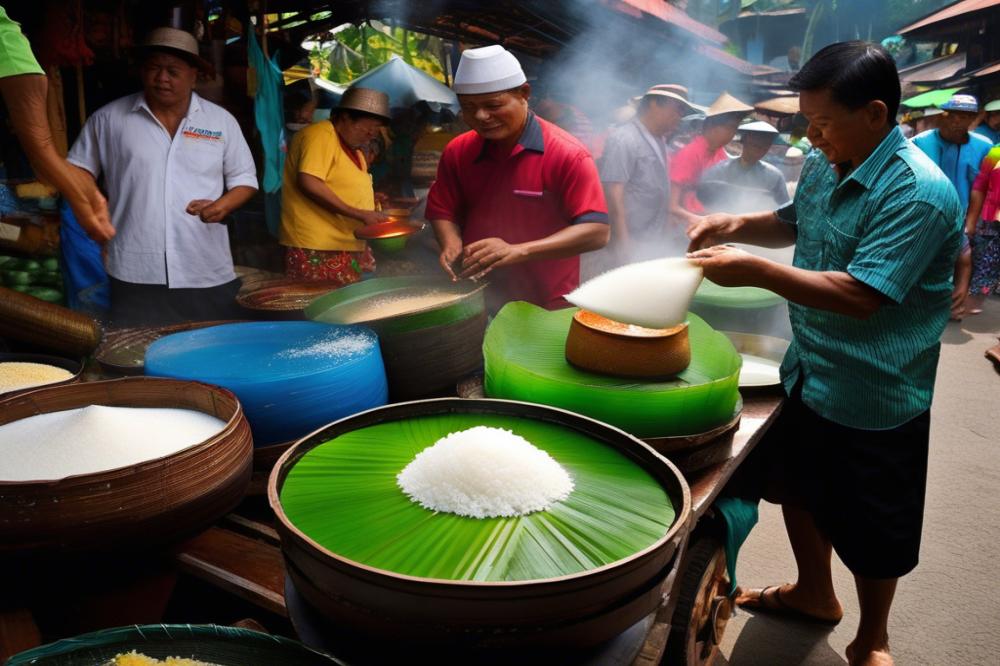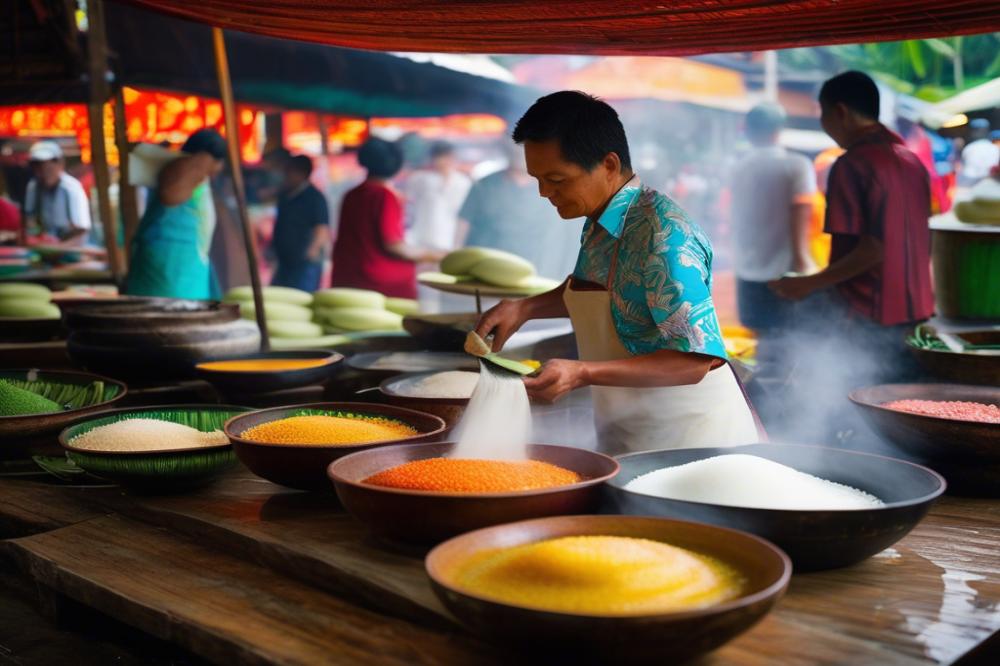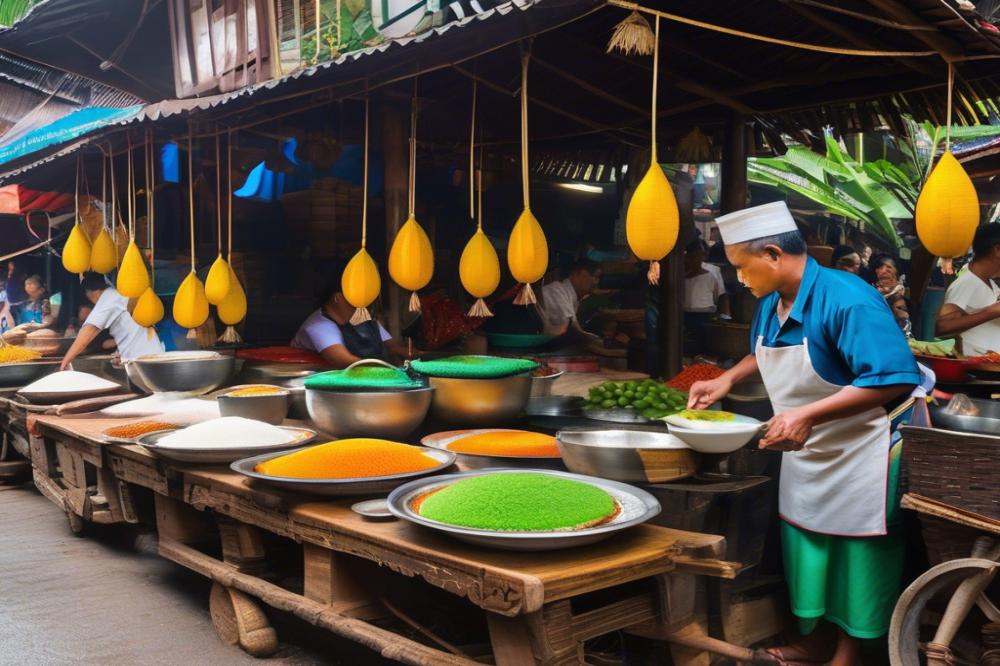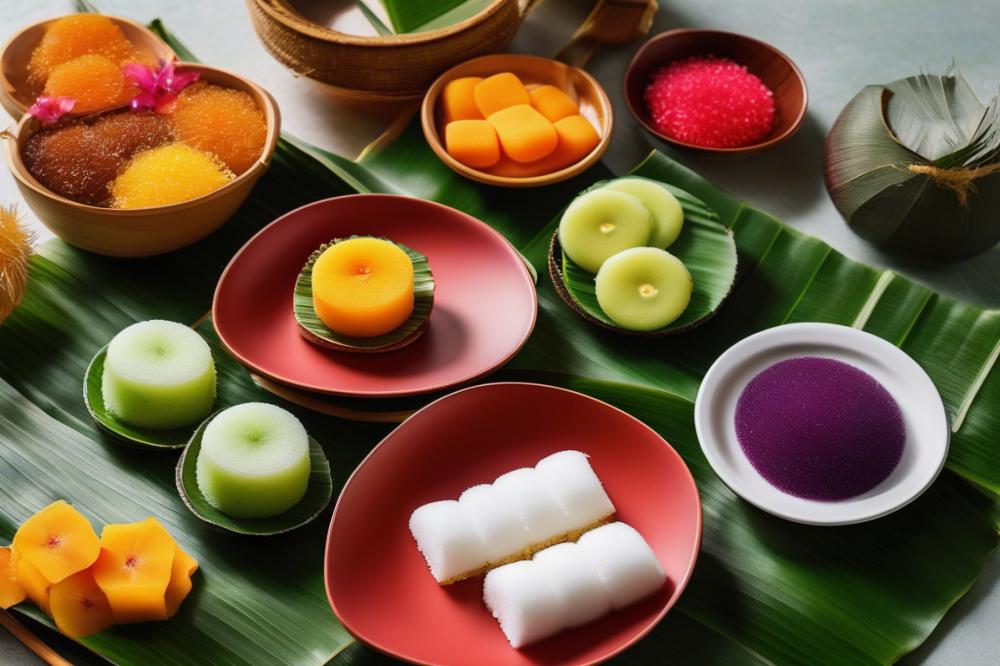Putu Piring Recipe: steamed rice flour cakes with palm sugar
Putu Piring is a delightful traditional dessert from Malaysia. Often enjoyed as a favorite street snack, it holds a special place in the hearts of many. The sweet treats are not just food; they represent a rich part of Malaysian food culture that emphasizes the joy of sharing flavors and experiences.
This dessert features a simple yet captivating combination of ingredients. The main component is rice flour, which gives Putu Piring its delicate texture. palm sugar provides a distinctive sweetness that melts in your mouth. Fresh coconut adds a layer of flavor that enhances its deliciousness. Together, these elements create a truly enjoyable experience for any dessert lover.
Preparing these steamed rice flour cakes may seem daunting, but it is actually an easy recipe. With the right measurements and a bit of patience, anyone can make them at home. Cooking methods involve steaming, which keeps the cakes soft and moist. Each bite is a reminder of how traditional recipes can bring people together, inspiring moments of happiness over shared food.
Putu Piring: The Recipe

Ingredients list
To make this delightful dessert, gather the following ingredients:
- 2 cups rice flour
- 1 cup water
- 1 cup grated coconut (fresh)
- 1 cup palm sugar (chopped into small pieces)
- 1/2 teaspoon salt
Cooking instructions
Begin by mixing the rice flour and salt in a large bowl. Gradually add the water while stirring. The mixture should be smooth and free of lumps. This step is essential for a nice texture. Once combined well, cover it and let it rest for about 15 minutes. This helps the flour absorb the moisture properly.
Next, prepare your steamer. It can be a traditional bamboo steamer or any steam pot available. Fill the bottom with water and bring it to a gentle boil. While waiting, take small cups or molds and line the bottom with grated coconut. This adds a delightful flavor and color.
After the mixture has rested, fill each cup about half full with the rice flour mixture. Add a few pieces of palm sugar in the center of each cup. Then, pour a little more of the rice flour mixture on top, covering the sugar completely. This ensures the sweet treat stays hidden inside. Leave a little space at the top as the cakes will rise when steamed.
Carefully place the cups in the steamer. Steam the cakes for around 10-15 minutes until they are cooked through. The rice flour should turn soft, but not too sticky. After steaming, let them cool for a minute before removing them from the molds.
Enjoy your Putu Piring warm or at room temperature. For the best results, serve them with extra fresh grated coconut on top. Combination of textures is part of the fun. These snacks are best when enjoyed fresh, capturing the essence of Malaysian food culture. If you’re feeling adventurous, try adding flavors like pandan or a touch of vanilla to the rice flour for a unique twist.
Creating the perfect Putu Piring is simple. Focus on getting the right texture of the rice flour mixture. Steaming carefully is key. Always keep an eye on the time to avoid overcooking. When ready, these sweet treats will leave a satisfying burst of flavors with each bite.
Nutritional Information

The key ingredients in this traditional recipe each bring valuable nutrients to the table. Rice flour serves as the main base for the dessert. It is gluten-free, making it suitable for those with gluten sensitivities. One cup of rice flour contains about 600 calories, with small amounts of protein and fiber. This makes it a good energy source.
Coconut is another critical ingredient in the mixture. Freshly grated coconut adds a delightful texture and flavor. It provides fat, mainly in the form of medium-chain triglycerides (MCTs), which can be easily burned by the body for energy. One ounce of shredded coconut offers approximately 100 calories and is also a source of dietary fiber.
Palm sugar contributes sweetness to this easy recipe. It is made from the sap of palm trees. Compared to white sugar, it contains more nutrients, including iron, zinc, and potassium. While still a sugar, it has a lower glycemic index. This means it won’t spike blood sugar levels as quickly as regular sugar might.
The combination of these ingredients creates a snack packed with energy. Enjoyed in moderation, these sweet treats can fit into a balanced diet. The nutrients from coconut and palm sugar can complement daily dietary needs. Additionally, savoring local desserts like this one strengthens food culture.
In summary, this unique dessert provides more than just pleasure. Its individual ingredients also offer benefits that contribute to overall health. Understanding these values helps appreciate the depth of flavors in these delightful rice flour cakes.
Cultural Significance of Putu Piring

History of Putu Piring in Malaysian cuisine
Putu Piring is a beloved dessert in Malaysia, with a rich history that dates back many generations. This traditional recipe showcases how Malaysian food culture has intertwined flavors and techniques from various influences. Originating from the Malay archipelago, it symbolizes the merging of different ethnic traditions. Many people enjoy this dish during festive occasions or as an everyday snack. Rice flour, used to create the delicate cakes, highlights the importance of rice in Southeast Asian cuisine. Recipes have been passed down through families, preserving the cultural identity of each community.
Influence of regional variations on the recipe
As part of Malaysia’s diverse culinary landscape, Putu Piring has many regional variations. In different states, you might find variations in ingredients or cooking methods. For instance, some versions may include additional flavors like pandan or even different types of fillings. Each region adds its twist, showcasing local ingredients. Palm sugar remains a consistent component, providing that signature sweetness. Coconut topping also varies, with some areas using fresh grated coconut while others may fry it for a textured crunch. These differences tell stories about the local communities and their preferences.
Putu Piring in modern Day Malaysia: where to find it
Today, this delightful dessert continues to thrive in Malaysia. Street vendors often serve Putu Piring, making it accessible for everyone. Food markets and hawker centers brimming with life and flavor are wonderful places to discover this sweet treat. Several cafes also feature this dessert on their menus, marrying tradition with contemporary flair. People appreciate how easy the recipe is, allowing more chefs to try their hand at making it at home. From bustling cities to quiet villages, the aroma of steamed rice flour cakes wafts through the air, drawing in those who cherish this tasty snippet of Malaysian heritage.
Enjoying Putu Piring
Serving Suggestions and Pairings
Putu Piring makes for a delightful dessert that can be enjoyed in many ways. Pairing it with a cup of warm tea or rich coffee enhances the flavors. The slight bitterness of these beverages complements the sweetness of the palm sugar filling beautifully. Some people even enjoy it with a drizzle of coconut milk on top. This adds creaminess and takes the experience to a new level. Serving them at parties can spark joy among guests, as these snacks are not just delicious but also visually appealing.
Variations of the Traditional Recipe
There are numerous ways to play with the traditional recipe. While palm sugar is the classic filling, you can also try variations. For example, some prefer to use chocolate or fruit pastes, like durian or banana. These fillings offer a different twist on the classic taste. Toppings can also vary. Consider adding crushed peanuts or sesame seeds for an extra crunch. Another popular option is to sprinkle shredded coconut on top, which provides a nice texture contrast. These different combinations highlight the rich food culture of Malaysia.
Tips for Making Putu Piring at Home
Creating this dish at home can be a rewarding experience. Start with high-quality rice flour for the best texture. It is crucial to mix the rice flour and water properly to form a smooth batter. Use a steamer that allows enough space between the cups for steam to circulate. This helps in cooking them evenly. Check the cooking time; they usually need about 10 to 15 minutes. After steaming, let them cool slightly before serving. Enjoying them warm ensures you experience the delightful melting texture. With a bit of practice, this easy recipe can become a favorite in your kitchen.
Wrapping Up the Delight of Steamed Rice Flour Cakes
Putu Piring stands out as a beloved dessert in Malaysian cuisine. This delightful treat combines soft rice flour cakes and sweet palm sugar. Each bite offers a blend of textures and flavors that many people cherish. Preparing these cakes at home is a rewarding experience that can bring families together. The simplicity of the recipe means that anyone can try their hand at making them, regardless of their cooking skills.
Exploring traditional recipes like this one helps keep culinary heritage alive. Many of these desserts tell stories of culture and community. When you bake Putu Piring, you’re not just following a recipe; you’re connecting with a rich history. Sharing these treats with friends and family can spark discussions about their origin and significance.
Consider giving this easy recipe a try in your kitchen. Gather your ingredients and take time to enjoy the cooking process. You may be surprised by how satisfying it is to create something both tasty and meaningful. As you learn and perfect it, you might find joy in passing on this delicious tradition to others. Every cake made is a step toward preserving the flavors of Malaysia’s past.



